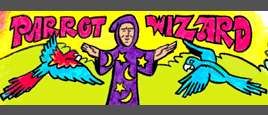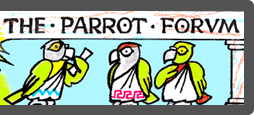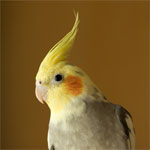I recently introduced my Cockatiel, Ladu, to the idea of him having to forage for food like cockatiels (and many other Parrots) would have to do in the wild. In this post, I will let you know how i taught my Cockatiel to forage and how to teach your parrot using the same method::
Step 1) To start your Parrot off, start by simply covering one of your Parrots food bowls with a tissue and poking holes in it, your Parrot will hopefully see that there is food in it and it should either poke it's beak in through the tissue to get the food out, or make the hole bigger so that it is easier to take the food out. REMEMBER, YOUR PARROT MAY NOT DO THIS AT FIRST, KEEP TRYING AND EVENTUALLY, YOUR PARROT WILL LEARN WHAT TO DO.
Step 2) After your Parrot has mastered the previous step (which will take a few days), try this: Grab a regular Paper Cup, and poke some holes in the side (the holes have to be big enough for your parrots beak to fit through). Then, fill the paper cup with your Parrots favourite treats and small foot toys. If you want to hang this toy, poke a hole through the bottom and thread on to some bird safe rope. The aim of this, is that the Parrot learns that if he pokes his beak through the cup, he will recieve the food. This will keep your Parrot busy and will keep his/her mind stimulated for a very long time.
Step 3) After your Parrot has mastered the previous step (this time, it should take about a week, because it is more challenging), then try to do the same thing with the paper cup, but don't poke the holes through, your Parrot should learn to poke the holes with its beak and then get to the food.
Step 4) After your Parrot has learned the previous steps, it has learned how to forage, now you can buy ForagingI toys without the worry of your Parrot not using the toy!
I hope this info has helped you very much! If you have any questions, do not hesitate to ask them.



Introducing your Parrot to "Foraging"
3 posts • Page 1 of 1
Introducing your Parrot to "Foraging"
My blog: http://the-buzz-online.weebly.com
"If we don't stand for something, we may fall for anything."
- Malcolm X"
"If we don't stand for something, we may fall for anything."
- Malcolm X"
-

laducockatiel - Amazon
- Gender:

- Posts: 845
- Location: London, England, Uk
- Flight: Yes
Re: Introducing your Parrot to "Foraging"
I tried the first step and he didn't do anything, he hadn't eaten since 4-8 in the evening so I ended up feeding him some food. I left it there until the next morning but he wouldn't eat breakfast either. Any ideas?
- CrazzMc
- Cockatiel
- Gender:

- Posts: 83
- Number of Birds Owned: 5
- Types of Birds Owned: Budgerigar, Cockatiel
- Flight: No
Re: Introducing your Parrot to "Foraging"
I have written down some tips on how to start out in the facebook page for parrot enrichment.
http://www.facebook.com/pages/Parrot-en ... 0220583389
As when it comes to any type of environmental enrichment, it is good to keep in mind how the particular species would forage in the wild. Cockatiels and parakeets feed mainly on seeds found on the ground which they find by poking through dirt. They also feed on flowers and buds on the ends of branches/twigs etc.
The need to forage is more or less genetic, the way they forage on the other hand is both genetic and learned. It's pretty complex, but i won't go in to detail on that right now. Basically, it's good to start out similiar to what it would look in the wild, but they soon learn to forage in many other ways as well.
Also, i normaly divide foraging in to two separate categories: quantitive and qualitive.
Basically, foraging enrichment that isn't very tricky but takes a lot of time, and foraging that requires some thinking to solve, such as pussle feeders. I use quantitative foraging every single day, and only use tricky foraging toys once in a while. This is normally the most effective combo.
To get birds used to the idea, start out with quantitive foraging, preferably something that's similiar to how they would find food in the wild.
For example, you can try placing chunks of veggies around the cage, put them on branches, poke them through bars, or even take a branch with lots of little twigs on it, spear the food on the ends of the twigs, andplace it in the cage. This is to get them used to the idea of not just looking for food in the food bowl, and it can be used even for experienced foragers, simply because it takes time even though they're good at it.
Also, you can mix their pellets or seeds with some wood chips, organic soil or finely shredded paper.
When i was taking care of tiels, i usually just dispered their seeds on the aviary floor among the wood chips. The whole flock would be down there kicking wood chips around to get those seeds, even when the same seed were available in food bowls. (This phenomena is common in all animals, and is called contra-freeloading).
If you don't want it directly on the floor, you can get a one of those things you use to collect water under flower pots and put at the cage bottom with soil/wood chips and seed in it, or just do it in the food bowl for starters.
Check out the facebook page if you want more tips on how to move forward after that.
I'm actually teaching a class on foraging enrichment on sunday, too bad you guys don't know swedish.
/S
http://www.facebook.com/pages/Parrot-en ... 0220583389
As when it comes to any type of environmental enrichment, it is good to keep in mind how the particular species would forage in the wild. Cockatiels and parakeets feed mainly on seeds found on the ground which they find by poking through dirt. They also feed on flowers and buds on the ends of branches/twigs etc.
The need to forage is more or less genetic, the way they forage on the other hand is both genetic and learned. It's pretty complex, but i won't go in to detail on that right now. Basically, it's good to start out similiar to what it would look in the wild, but they soon learn to forage in many other ways as well.
Also, i normaly divide foraging in to two separate categories: quantitive and qualitive.
Basically, foraging enrichment that isn't very tricky but takes a lot of time, and foraging that requires some thinking to solve, such as pussle feeders. I use quantitative foraging every single day, and only use tricky foraging toys once in a while. This is normally the most effective combo.
To get birds used to the idea, start out with quantitive foraging, preferably something that's similiar to how they would find food in the wild.
For example, you can try placing chunks of veggies around the cage, put them on branches, poke them through bars, or even take a branch with lots of little twigs on it, spear the food on the ends of the twigs, andplace it in the cage. This is to get them used to the idea of not just looking for food in the food bowl, and it can be used even for experienced foragers, simply because it takes time even though they're good at it.
Also, you can mix their pellets or seeds with some wood chips, organic soil or finely shredded paper.
When i was taking care of tiels, i usually just dispered their seeds on the aviary floor among the wood chips. The whole flock would be down there kicking wood chips around to get those seeds, even when the same seed were available in food bowls. (This phenomena is common in all animals, and is called contra-freeloading).
If you don't want it directly on the floor, you can get a one of those things you use to collect water under flower pots and put at the cage bottom with soil/wood chips and seed in it, or just do it in the food bowl for starters.
Check out the facebook page if you want more tips on how to move forward after that.
I'm actually teaching a class on foraging enrichment on sunday, too bad you guys don't know swedish.
/S
-

Avialae - Lovebird
- Gender:

- Posts: 47
- Number of Birds Owned: 0
- Types of Birds Owned: Jardines, Senegals
- Flight: Yes
3 posts • Page 1 of 1
Return to Toys, Accessories, and DIY
Who is online
Users browsing this forum: No registered users and 13 guests
